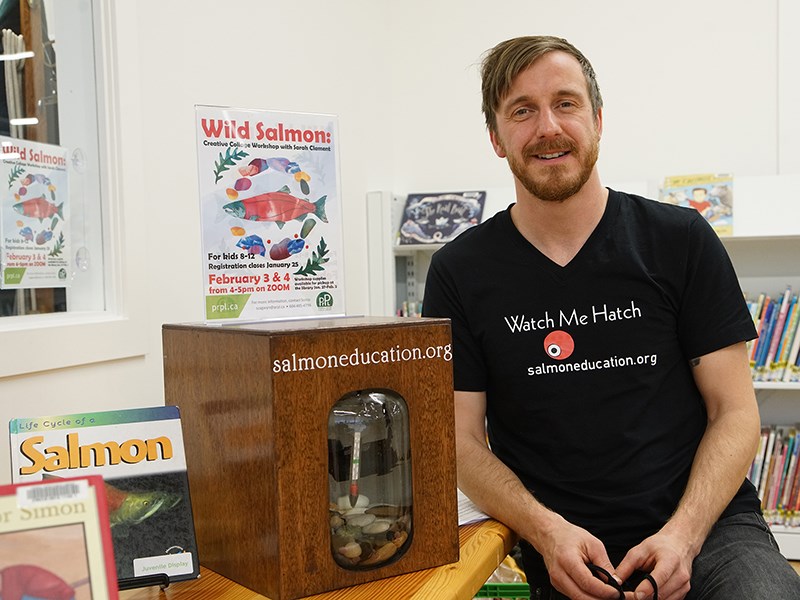Powell River residents will be able to observe early stages of the life cycle of coho salmon at Powell River Public Library.
A display featuring eight coho eggs is situated in a specially built tank, located in the children’s reading room at the library. Along with the mini aquarium is a display of books that relate to salmon.
Tyler Bartfai, a hatchery technician with Powell River Salmon Society, set up the display.
“We knew with COVID-19 coming around that things were going to look different this year in classes,” said Bartfai. “As well, we thought it was an opportunity to expand to the broader public to showcase some of the issues salmon are facing. We have set the framework and show the framework and the basics of salmon life cycles and Pacific salmon in general.
“It’s about trying to make the community aware of Pacific salmon and how iconic of a species it is. We feel specifically that ground-level education is the best way to inform people and it starts with younger people, the youth, around the issues salmon are facing, to hopefully give the salmon a more viable future.”
Bartfai said the salmon will probably be in the library for two months, until they start feeding and have to be taken back to the hatchery. In addition to the library display, there is a livestream at salmoneducation.org, featuring another small aquarium with coho eggs. The livestream can be accessed on the homepage of the website. If people cannot get out to the library or are isolating, they can still monitor the progress of the salmon eggs.
Eggs that are in the library were taken in November. Bartfai said it will likely be a couple of weeks before the eggs morph into alevin, which is the next phase of the salmon lifecycle. He said alevin are still feeding on their yolk sacs. It will be another few weeks after that until they start to absorb most of the yolk sac and start feeding as salmon fry.
In total, there are eight eggs in the library display. Bartfai tried to keep the eggs close to the front of the glass so people can easily observe them.
In the not-too-distant future, Bartfai said the alevin will be free of the eggs and be seen moving in the aquarium.
Bartfai said the salmon society is hoping the display will help young people develop a lifelong interest in Pacific salmon. He said it is hoped that youngsters will ask questions and get their parents involved, and anything that “gets the gears turning.”
In terms of the salmon society’s collection this year, it was a good year at the hatchery this fall. There was a strong return of chinook salmon, just above average for coho, and chum were a bit down this year, but the hatchery was still able to get its requirements – just under two million eggs, said Bartfai. He added that the chum have all been moved up to the Duck Lake hatchery and the chinook and coho are in the hatchery at the Catalyst mill.
The showpiece displayed in the library was designed by Powell River Salmon Society. Bartfai said some shopping around for some of the components was required; he built the prototype box, then the final version was created.
He said the hatchery has had experience with larger tank systems for salmon but they come with greater complications and are more difficult to transport.
“We went back to basics,” said Bartfai. “We know what works.”
There is also a unit at Kelly Creek Community School and the coho eggs hatched very recently so students there were excited about the alevin being out, he added.
If the displays engender interest and people have questions, they can make contact with the salmon society through salmoneducation.org, or get more information at prsalmon.org. Bartfai said the education program and a lot of the fish culture activities are community and corporation supported.
“We’re always welcoming feedback and anyone who is interested in getting involved in any way can contact us,” he added.
Bartfai said Pacific salmon face a lot of challenges but some can be overcome by everyone making small changes. He said a lot of times, that involves young people becoming interested.
For people visiting the display, Bartfai said there are some colouring resources and small grab items they can take. There are also some learning modules on salmoneducation.org so people can find age-specific resources to broaden understanding about salmon.
Bartfai said all of the workers with the salmon society feel their work goes beyond being a job because they are all passionate about salmon. He said that is part of why expansion into education is so pivotal, to get people involved and hopefully provide a brighter future for salmon.
Sonia Zagwyn, the library’s children’s services coordinator, said she was excited to be contacted by Bartfai.
“It’s a fantastic learning opportunity for kids,” said Zagwyn. “I know my son is going to be able to get up close to some salmon eggs and see them hatch.
“Also, it’s a new year and new life. It’s really optimistic. We don’t have a lot of programs running right now within the library; we have a lot of remote programs happening, so it’s really exciting to have something live and interesting where kids can see something new and different happening in the library.”
Zagwyn said she was also happy to support salmon education efforts.
She added that the library is partnering with an artist from the lower coast, Sarah Clement, who does art workshops based around conservation themes. Clement is going to do a two-day salmon-themed workshop with the library on February 3 and 4 for children ages eight to 12. Registration for the program closes January 25 and people can contact Zagwyn at the library at 604.485.4796 for more information.



